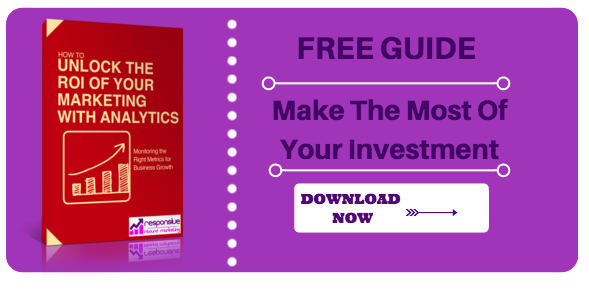25 Inbound Marketing Analytics You Can Benchmark Yourself Off Of
 There's more to inbound marketing analytics than just monitoring website traffic and page views. It's about connecting the dots with every data trail your visitors leave behind so that you can make better business decisions and improve performance. We know it can get overwhelming when you analyze the wealth of inbound marketing data on a regular basis in order to see what is or isn't working for you. Luckily, we're here to help make your life easier.
There's more to inbound marketing analytics than just monitoring website traffic and page views. It's about connecting the dots with every data trail your visitors leave behind so that you can make better business decisions and improve performance. We know it can get overwhelming when you analyze the wealth of inbound marketing data on a regular basis in order to see what is or isn't working for you. Luckily, we're here to help make your life easier.
Every smart marketer measures the effectiveness of their inbound marketing campaign with powerful tools and knowledge as benchmarks for success. And they do it by saving time and choosing marketing metrics that matter.
- Organic Traffic
Every organization using inbound marketing strives to increase organic traffic to their website because it's cost-efficient and it's the #1 driver of quality visitors and leads. Organic traffic is a positive indicator that people are finding your products or services through a search engine. This is all thanks to your SEO strategy. Make sure to monitor this number and remember to factor in relevant, strong keywords into your content marketing efforts.
- Referral Traffic
Measure the number of traffic you're getting from external sites including social networks like Facebook and Twitter. If these referrals are driving traffic, especially conversions right to your door, start focusing your content marketing efforts on these.
- Bounce Rate
The amount of time a visitor spends on your web page says a lot about their interaction with your website. A good bounce rate falls between 26% to 40%, according to TechWyse. If your pages have a low bounce rate, then you must be doing something right. Otherwise, you'll need to improve the quality of those pages with a high bounce rate so that your visitors stick around a little longer. Ask yourself if your landing page needs some tweaking in design or if it contains a clear conversion path.
- Email Addresses
The number of email addresses you capture through your site can serve as a metric to your email marketing efforts. Example, your goal might be to increase your email database to 1,000 contacts within 6 months. Emails are also a great way to nurture visitors so that they turn into qualified leads. As much as emails are a powerful sales tool, also make sure that you provide your recipients with the option to "opt-out" of receiving them.
- Social Media Following
How many of your visitors and conversions are being driven to your site by social media? Use this metric to see how well your brand is engaging with the online public. A decrease in followers means adjusting your content, approach, or possibly your overall campaign.
- Lead Conversion
Track the number of traffic-to-lead ratio. Are your website visitors actually clicking on your call-to-action button and completing the form? The average landing page conversion rate is 5% to 15%, according to HubSpot. If numbers are low, that's when you know you need to take action. Maybe a change in your site's design, text, or form is required. What's more is that the lead conversion rate tells you exactly where your leads are coming from (social media, organic, referral, etc.) which will help you to optimize keywords.
- Engagement
Brand success includes socially engaging with your online audiences, an important factor to incorporate into your inbound marketing analytics. If your content is not prompting people to retweet, mention, share, or ask questions, then you're missing out on some serious revenue opportunities.
- Email Open Rate
Monitor the number of emails opened after a campaign launch or monthly newsletter, for example, in order to gauge where your email marketing strategy needs improvement. HubSpot reports an adequate 16-30 email campaigns per month should have an average open rate between 32.2% to 35.3% depending on the company size. If your open rate is not impressing you, watch it rise after using these 5 key elements.
- Click-Through Rate
You can tell what resonates with your audience by how often they click on an a call-to-action button or link. By benchmarking your CTR based on the quality of your images, keywords, valuable content and a clear call-to-action, you can increase the click rate by 583%.
- Lead-To-Customer Ratio
Are your lead nurturing efforts paying off? Do you have a high close rate? Maximize this metric by evaluating your sales process or working with your sales team to increase your numbers.
- Return On Investment
Assessing your monthly or annual ROI with inbound marketing analytics gives you a glimpse of where your time is best spent. Example, you will be able to determine which social channels works best for you, and decide on the most relevant content to post for your target audience. At the same time, you'll be able to plan strategies and budgets for the following months/year ahead.
- Unsubscribe Rate
The average email unsubscribe rate across all industries is less than 2% which is considered the norm according to Campaign Monitor. There are ways you can help prevent your leads from unsubscribing to your emails, e.g., always send relevant content according to your segmented list, and make sure you're not bombarding them with too many emails.
- Blog Visits
An effective approach to using this metric is to look at your blog performance in three ways: unique visitors, total page views, and time spent on a page. This way, you'll see if your blog post is reaching people, if there's an increase in total pages viewed, and if each post is engaging enough to hold your visitor's attention.
- Returning Visitors
Brand followers who come back for more is a wonderful achievement, all the more reason to ensure your inbound marketing efforts are constantly optimized. Gauging the number of returns to your site brings your focus to moving those visitors further down the sales funnel.
- Inbound Links
An inbound link is a link posted by another website that points to a web page on your site. It serves as valuable reference to your content and an opportunity to rank higher in search engine results pages - it's definitely worth incorporating in your inbound marketing analytics.
- Social Shares
Think of your brand followers as your promoters. With each social share on Facebook or Twitter, your company message appears in the feed of hundreds of people, and thus reaching a larger audience. Using the right social media channels can be a powerful tool for your business.
- Keyword Ranking
The ultimate goal with keywords is to be found on search engine results pages. In order for that to happen, you need to create quality content to draw in readers and slip in keywords that your prospects used to find you online. Tracking this is a great way to see if your efforts are producing a desired effect.
- Reader Comments
Stay in touch with visitors who leave a comment or question on your blog posts. It's an opportunity to build loyalty and lead conversions. Measuring the number of reader comments gives a glimpse at whether or not you're striking gold with your visitors. If you think your blog posts could use some commentary, think of ways you can encourage readers to participate in the discussion of your posts.
- Content Quality
When measuring the quality of your content, it's just as important to analyze the posts that performed low as the ones that generated the most hits. Make sure you're adding value to your content that resonates with your buyer personas - provide educational and relevant information. HubSpot reported 43% of marketers generated a customer through their blog in 2013.
- Competitive Analysis
Compare your campaign performance on social media to that of your competitors. You would want to gain insight on the total number of mentions or shares for your brand vs. your competitors. Use a social media analytics platform like Buffer or Social Mention to track social performance.
- Delivery Rate
Email marketing relies upon the success or failure of your sent message. Calculate the percentage of emails that delivered to recipients' inboxes and take into account the number of hard bounces, either due to a full mailbox, the server being down, or the message was too large.
- Speed
There's nothing more off-putting for an internet user than waiting for a page to load. An increased page load time will only chase visitors away. Measure how well your website is working by checking for any broken links and codes, images that take up a lot of bandwidth, overuse of rich content on a single page, etc.
- Mobile Traffic
It's important to know how much of your website traffic is coming from smartphones because you will understand how your visitors are generally searching and viewing information. Use this metric to plan out your mobile marketing strategies for better business results.
- Most Popular Pages
Besides the homepage, which pages are driving the most traffic and why? Once you can point out the content that is making the most impact, you'll have better knowledge of your visitors' interests and, as a result, give them more of what they want.
- Lifetime Customer Value
Last but not least, don't forget to keep your current customers happy. Doing so will extend your customer's lifetime value. Calculate the LTV by following this traditional formula:
(Average Value of a Sale) X (Number of Repeat Sales) X (Average Retention Time)



